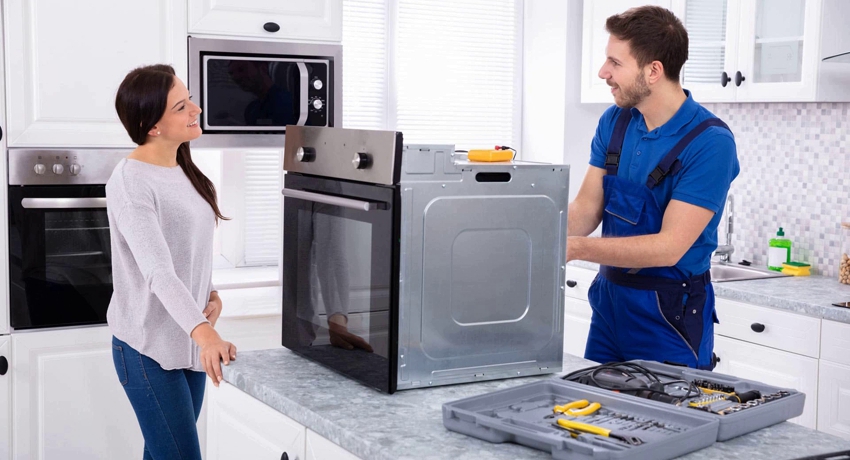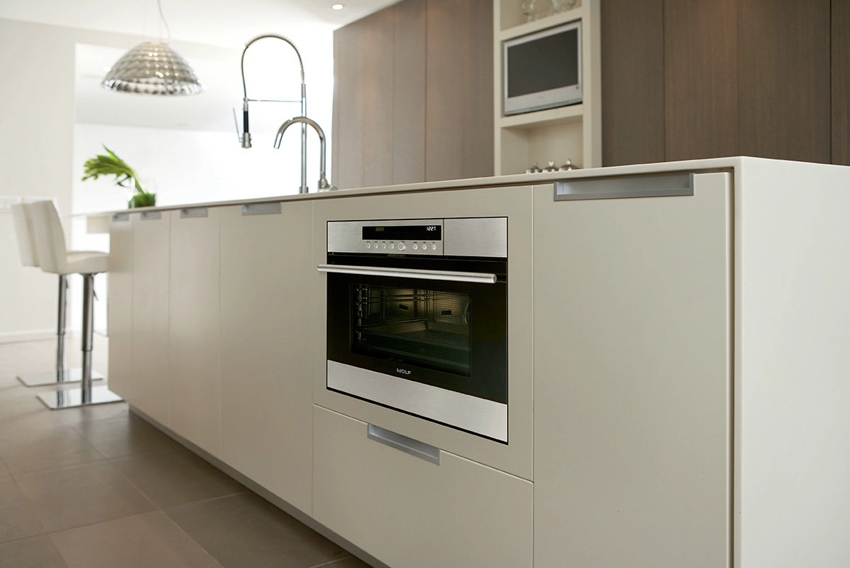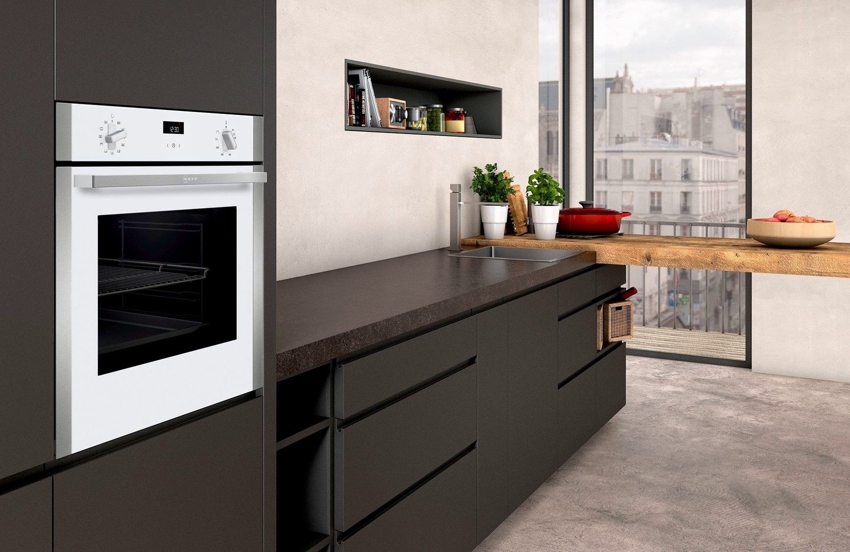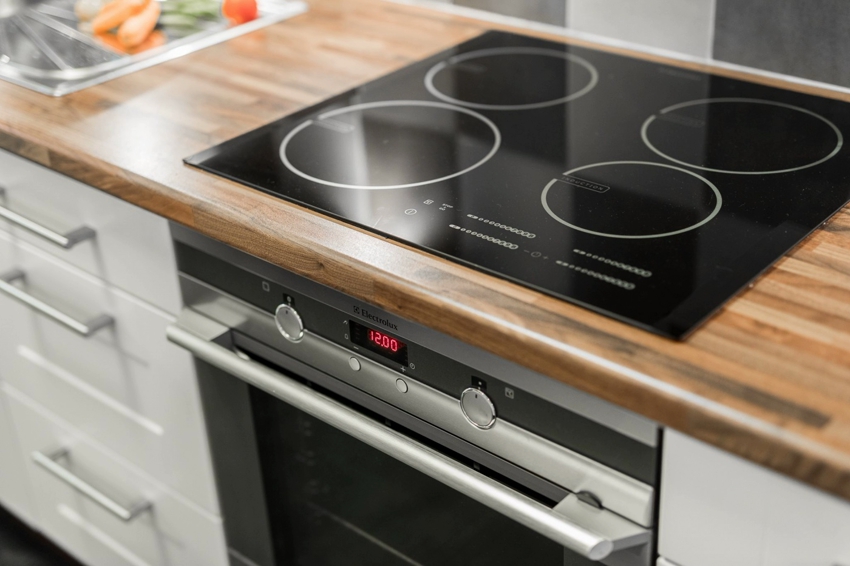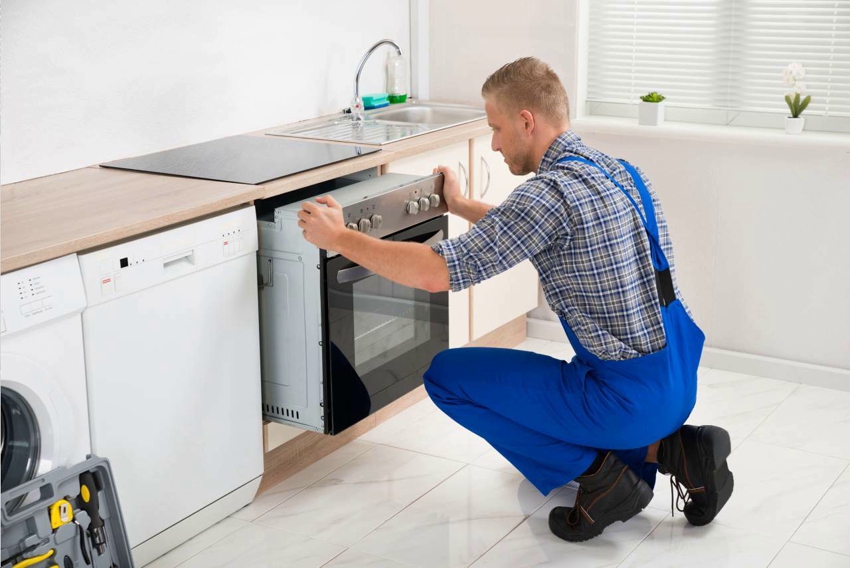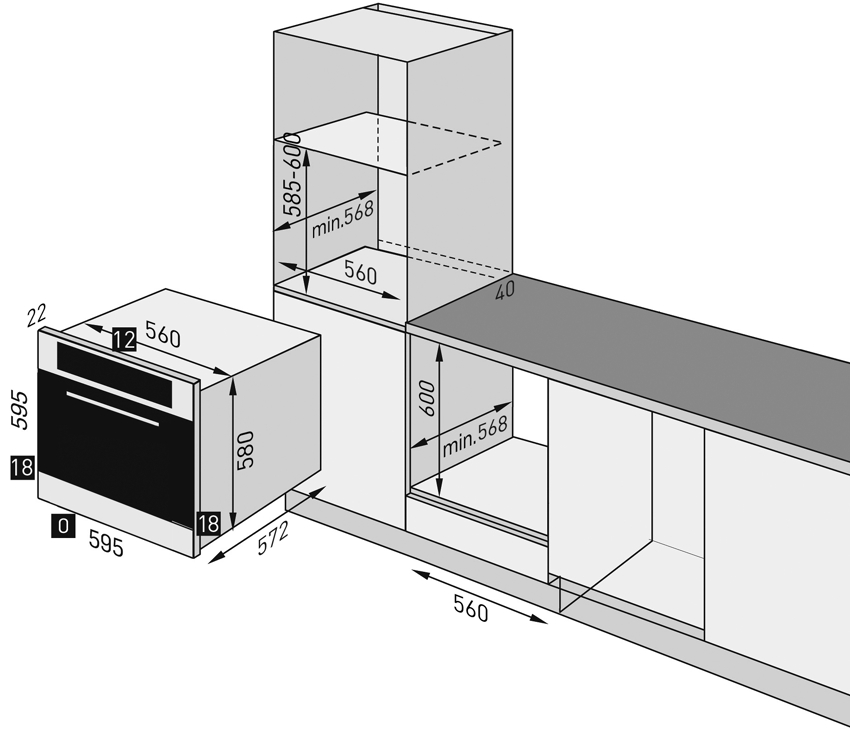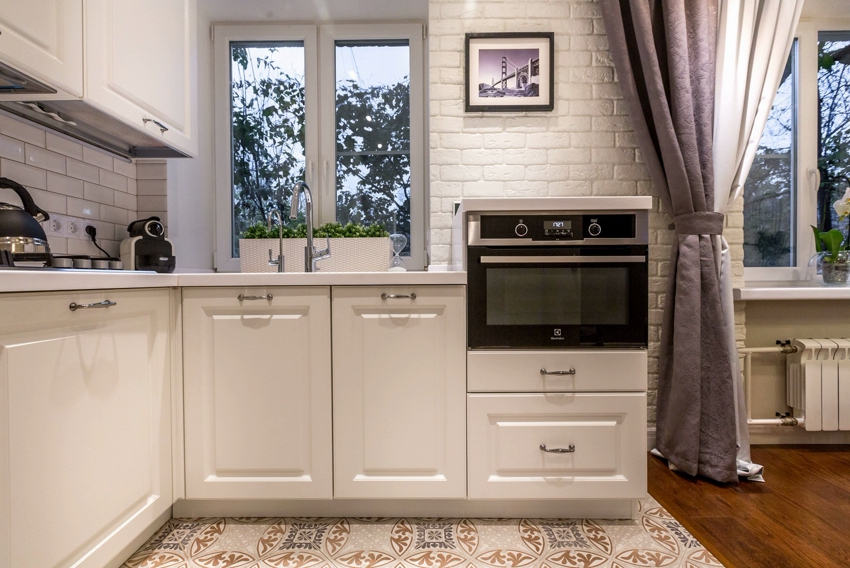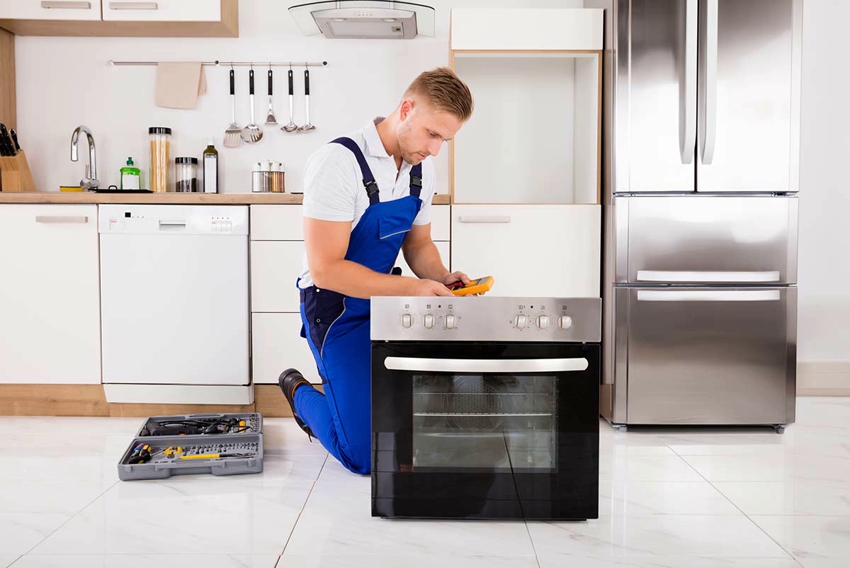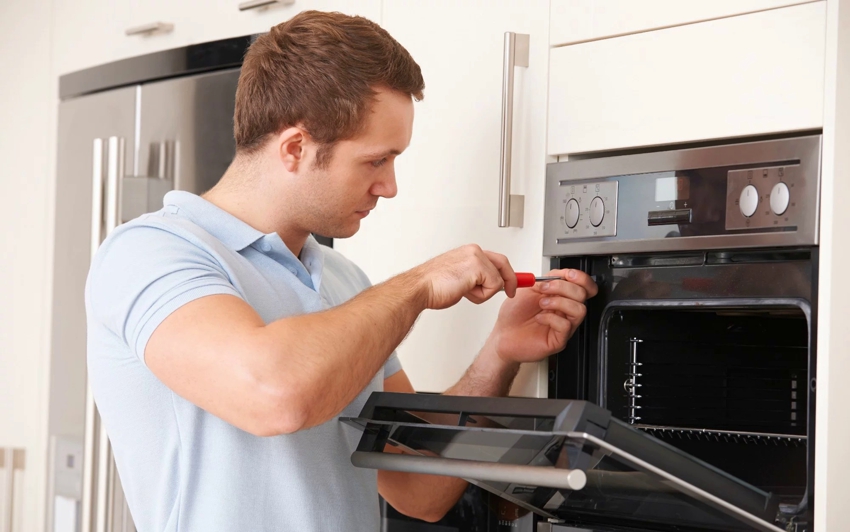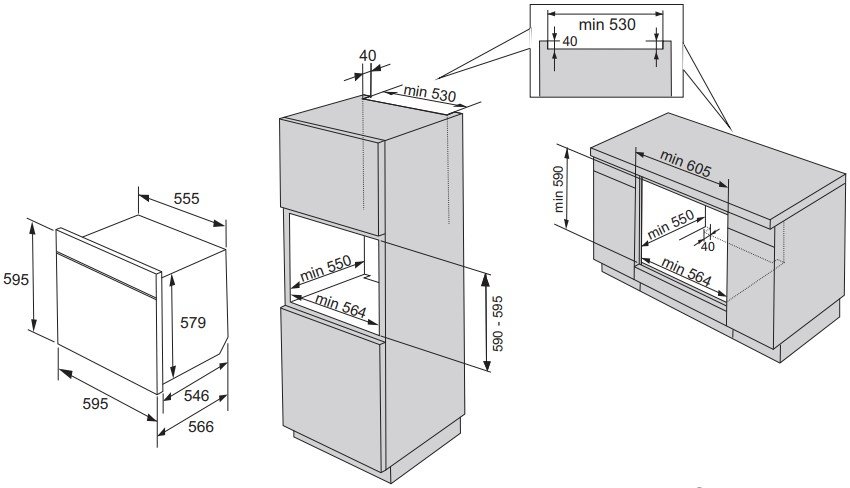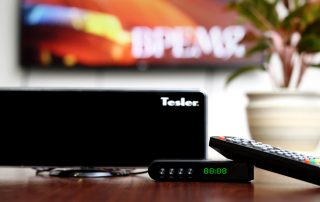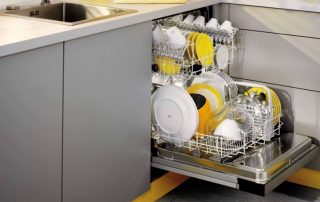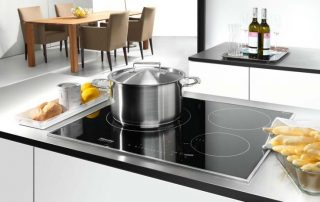In order for the cooking process to be fast, high-quality and enjoyable, it is important to take into account a number of nuances. We are talking not only about the useful area in the kitchen, the right choice of dishes, tools and appliances, but also about the peculiarities of their location in the room. One of the main factors for the comfortable use of the kitchen space is the correct installation of the built-in oven. This article will tell you about the features of the choice of equipment and its fast and most importantly safe installation.
Content [Hide]
- 1 Oven in the kitchen: the purpose of the appliance
- 2 Installing the built-in oven: types and configuration of appliances
- 3 How to install a built-in oven: choosing a place for appliances
- 4 How to install the oven
- 5 Installing the built-in gas oven: general recommendations
- 6 Secrets and subtleties of installing the oven: video installation
Oven in the kitchen: the purpose of the appliance
The oven in the kitchen is an indispensable assistant for any housewife and other family members who are fond of the cooking process. It's no secret that a dish cooked in an oven is much healthier than a dish fried in a pan with oil. Homemade pies baked in the oven are much more luxurious and flavorful than those purchased at the bakery.
An important criterion for choosing a device is, of course, personal preferences, and the main condition for safe operation is the correct installation of the device. Appliance manufacturers do not recommend independent installation of ovens, but at the same time, knowing the sequence of work, material requirements and connection features, you can install the oven yourself.
When purchasing an oven, first of all, it is necessary to determine its type and type of power supply. It is equally important to determine the manufacturer, the specific model and the location of the equipment. Taking into account the rules of ergonomics, even in a miniature kitchen, you can successfully place a multifunctional oven. Going to the store, you should not forget about the functionality of the equipment. In this case, it is worth considering such criteria as the availability of cooking options, a timer, readiness sensors, additional functions and temperature conditions, as well as the features of installing the oven.
The versatility of the oven is especially important for those people for whom cooking is not just a process, but a kind of art. For chefs who often use the appliance, it is important to have a self-cleaning function. At the same time, it is worth considering the fact that you will have to pay much more for additional functions.
Oven: separate or dependent, and other selection options
You can determine a number of basic parameters that should be followed when choosing an oven. These include:
- safety;
- type of control;
- functionality;
- appearance;
- installation features.
Important! An electric oven belongs to the category of high-power household appliances, therefore, the house must have appropriate electrical wiring, and the installation and connection of the oven itself takes place through a power wire to a special machine.
Safety provides for gas control for gas appliances, and timers for electric ones. The control type can be automatic or mechanical. The mechanics differ not only in price, but also in simplicity and reliability. At the same time, when installing an oven of this type in a kitchen, problems may arise, since it does not fit into ordinary niches for embedding.
Multifunctional ovens are equipped with an electronic control unit. It has smaller dimensions, which makes the device with key or touch buttons more convenient during operation. In addition, recipes for your favorite dishes can be stored in the device's memory. It is also possible to install an electric oven with a combined control type in standard niches. Such devices, as a rule, are equipped with an electronic scoreboard and mechanical controls. The design of the oven should correspond to the style of the room, and is kept in color with the rest of the appliances.
When installing an oven built under the hob, pay attention to the type of connection. It can be autonomous or connected to the hob. This factor is also important when choosing a technique. Connected devices are connected via one power cable in accordance with the instructions. Independent ovens are connected using two different conductors, so they can be installed at any distance.
Installing the built-in oven: types and configuration of appliances
Before you install a built-in oven, you should understand the types of these household appliances. In this regard, they are divided into electric and gas.
Gas is considered traditional, as it has been in most kitchens for many years. Gas ovens are preferred for a reasonable price and ease of use, since most of these ovens are built right into the stoves. At the same time, gas appliances also have their drawbacks, since the dishes are baked unevenly and there is a risk of burning. In addition, the use of natural gas in itself is unsafe, and the installation of a gas oven clearly requires the involvement of the hands of an experienced professional master in order to avoid disastrous consequences.
Electric ovens guarantee fast cooking with even cooking. Their ubiquitous installation began in metropolitan areas, where many multi-storey buildings lack natural gas connections. The cost of different models depends on the functionality and the manufacturer's firm. The installation of an electric oven provides for the presence of reinforced reliable wiring and a separate special RCD machine.
Useful advice! When choosing a gas oven, you should give preference to models that are equipped with leak limiters, the so-called gas control function.
Ovens are also distinguished by the type of installation.They can be dependent, which provides for the mandatory installation in tandem with the hob. Independent appliances are ovens that are installed as independent appliances. They can be built-in or free-standing. It is possible to install the built-in oven in a pencil case or in a special niche.
How to install a built-in oven: choosing a place for appliances
An important aspect of the efficiency of using the oven is the correct location for its placement. It should be accessible and convenient. There are several typical locations.
Under the countertop - This is the simplest and most common oven mounting variation. The installation scheme for an oven of this type is distinguished by its simplicity and lies in the fact that it is placed directly under the countertop in a specially designated niche away from sinks and other appliances. This type of installation provides for the simultaneous adjacent installation of the built-in oven and the hob. The result is an autonomous cooking zone.
Installing the oven in a kitchen set autonomously from the hob suggests various options. This can be installed in a pencil case at belt level or in a special column, as well as on a pedestal.
Island location involves the installation of a stove with an oven in the center of the room on a special kitchen island. This option is only suitable for spacious kitchens or for large studio apartments, where the kitchen is combined with the living room. In other cases, the island will negatively affect the functionality of the kitchen. And connecting to the wiring when choosing this option is permissible only through the floor, the level of which is raised, creating a kind of podium. Which, in turn, requires ceilings of a certain height.
Installing an oven in a kitchen set: options and features
If the oven is supposed to be located in the niche of the kitchen set at the waist level or slightly higher, then the cutout is adjusted to the size of the cabinet in advance. Then all edges are covered with a protective tape to avoid problems when installing the oven. When the installation of furniture in the kitchen is completed, an oven is inserted into the prepared cut-out.
Separate installation of the oven and hob is also assumed when the cabinet is built into the column. In this case, the cooking surface is installed autonomously on the countertop above one of the cabinets. Installing the oven in a pencil case or embedding in a column involves placing it above the drawers, microwave or under it. This installation option creates a stylish look in the kitchen and is quite convenient, since the oven is located at eye level, and you do not need to bend over to it to observe the cooking process. The advantage of this arrangement is that children or pets cannot reach the control panel and door handle.
Note! If it is planned to install a built-in electric oven of low power, which does not exceed 3.5 kW, then a simple connection to the outlet is permissible.
Perhaps the location of the oven in one of the headset cabinets, but at the same time it will be located at some elevation from the table top. Choosing this option, even before drawing up a kitchen project, it is necessary to correctly select a design and material that will withstand the weight of household appliances and will not give in to deformation during the heating process. In this case, the height of the oven is also important, which should not exceed the height of the hostess.
Another way to install it in a headset is corner placement. Despite the fact that sinks are mainly installed in the corner, it is much more rational to design the "wet" area closer to the window in order to provide better lighting.In this case, you should select the correct dimensions for the equipment in the corner cooking zone.
Is it possible to put the refrigerator next to the oven
Correct installation of the built-in oven assumes a competent neighborhood with other household appliances. This is especially important to consider in a small kitchen, paying attention to the location of heating appliances and a refrigerator nearby. It should be noted right away that such a neighborhood is undesirable, since both devices generate heat during operation, which negatively affects the performance of the devices.
The refrigerator must be installed in such a way that there is sufficient space around it for air circulation, which is necessary to cool the air around the unit. Excessive heat for the oven is also undesirable, as it affects the temperature rise and even the formation of a flame inside the oven. The consequences can be the most undesirable.
In an extreme case, the neighborhood is still possible, but at the same time, a distance between the devices of at least 15 cm should be observed. This space can be filled with a special narrow cargo cabinet. The use of a heat shield that reflects heat also minimizes unwanted neighborhood factors. For this purpose, you can stick heat-reflecting foil on the refrigerator.
If you plan to install built-in household appliances, then placing a refrigerator and an oven next to it is quite acceptable, but provided there is a heat-insulating layer on the walls of the kitchen unit, as well as circulation gaps that ensure the normal operation of the refrigerator and electric oven.
How to install the oven
After choosing the type of appliance and a specific model, it is necessary to carry out certain preparatory work before proceeding with the installation of the built-in oven with your own hands. Particular attention is paid to the preparation of walls and furniture. Kitchen furniture and appliances are made according to established templates, so the purchase of a built-in oven can be postponed until the final stage of the repair. Most often, an oven 45 cm wide is selected for installation in a niche. This is the standard size of the instrument.
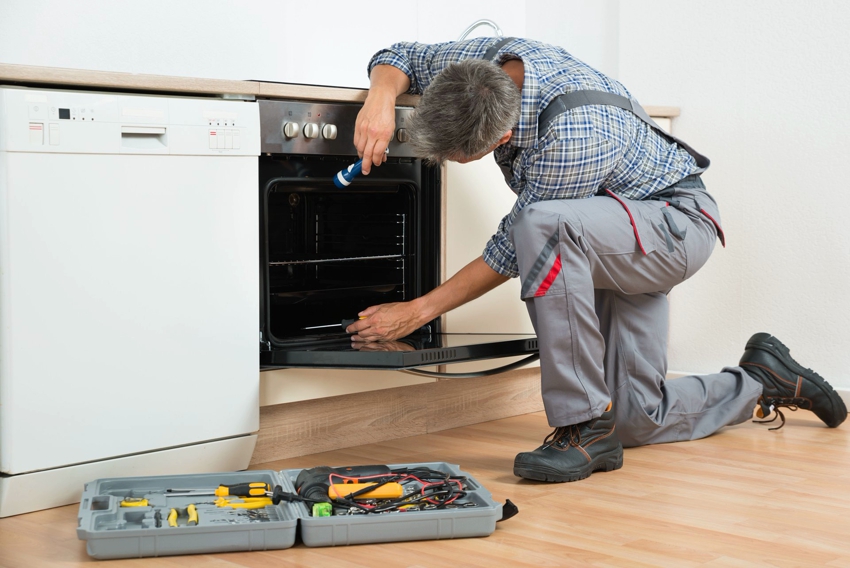
The place for the installation of the oven must be provided even at the planning stage of the kitchen set
Helpful advice! Kitchen furniture should be level. Even a slight misalignment can lead to failure of the electronics in the electric oven, or uneven heat distribution, when it comes to gas models.
As for the niche itself, you need to take care of the absence of distortions. Uneven surfaces can result in uneven weight distribution of heavy equipment. The niche should be slightly larger than the size of the oven. At the back of the oven, it is necessary to provide at least 4 cm, at the bottom - at least 9 cm and 5 cm on each side. Such intervals will avoid overheating and deformation of furniture and appliances.
In advance, even before installing the kitchen unit, it is necessary to determine the power source and, if necessary, replace the gas pipes and inlet taps or electrical wiring.
Built-in oven installation: electrical installation
Installing a built-in electric oven requires reliable electrical wiring and an appropriate RCD or at least a power outlet with grounding if the repair was done a long time ago and the installation of the electrical panel is problematic. In the choice of wiring, copper with three cores should be preferable. The wires must be at least 10 cm high and the amperage must be at least 40 amps. If there is separate wiring, make sure it can handle the current to avoid short circuits.
When working with an electrician, a number of rules should be followed:
- it is unacceptable to connect wires to each other by twisting;
- you can not directly connect the aluminum wire with copper;
- use special screw terminal blocks to connect the wires;
- connect the wiring to the electrical panel through a separate machine.
When installing a do-it-yourself electric oven, special attention should also be paid to the plug. Modern models are usually equipped with massive, high-voltage plugs. Defects, rust or other damage to them are unacceptable.
Related article:
Dishwasher: do-it-yourself installation in a kitchen set
Installation features. Preparing for installation. Dishwasher sizes. Mounting options. Installation technology for embedded PMM.
The end of installation involves connecting all wires and connecting the device. Before using the oven, it is imperative to check its operation, so that later you do not have to dismantle the equipment. The wiring should be placed in a special hole in the niche to avoid pinching the wire and deforming it.
Features of installing Bosch and Electrolux ovens
The installation of the Bosch oven is quite simple and involves only plugging into an outlet, however, a special separate fuse must first be installed on it. Dependent ovens that are connected to an electric stove imply a direct connection to a high voltage current, so the installation of such equipment must be carried out by a qualified electrician.
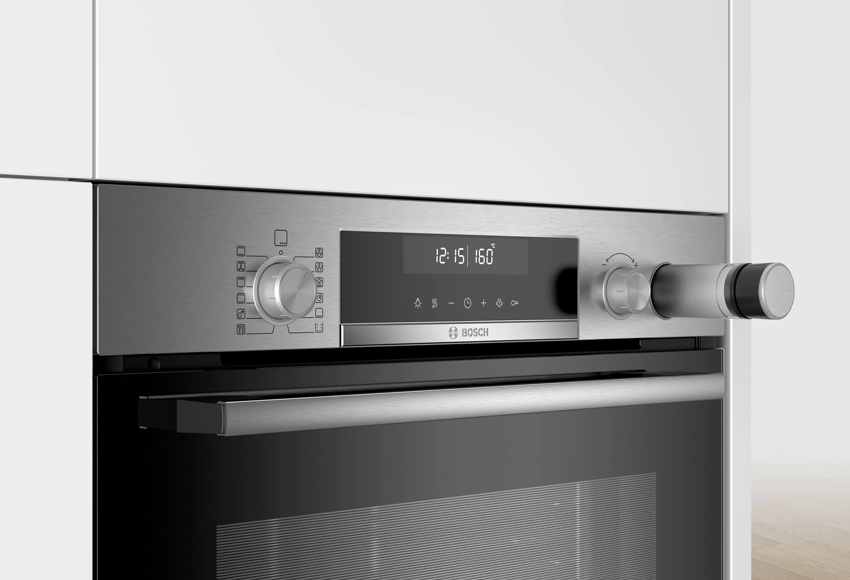
Individual manufacturers can specify individual requirements for the installation of their equipment
If we are talking about installing a compact oven, then you should first get acquainted with the diagrams and recommendations that are attached to a particular model. It is also advisable to watch a special video of installing the built-in oven with your own hands on the manufacturer's website.
Important! If you have the slightest doubt during the installation of an electric type oven, you should seek the help of an experienced electrician.
The installation of the Electrolux oven has its own nuances. Equipment from this manufacturer is distinguished by a high level of built-in electronics and a number of protective functions. For example, in accordance with the instructions for a number of models, the first switching on of the oven, and all subsequent ones, is possible only after setting the time.
Installing the built-in gas oven: general recommendations
The installation of built-in gas-powered kitchen equipment involves a number of certain difficulties. The main problem is connecting the main gas pipeline to the instruments. The greatest number of difficulties arises during the installation of built-in gas equipment.
Regardless of whether it is planned to install a gas hob and an electric type oven, a compact gas stove or a dependent oven from the hob, in any case, a main gas system will be required. Only qualified and certified specialists are authorized to perform this work. Independent interference in the gas pipeline at any of its sections is unacceptable, since it is dangerous not only for the inhabitants of a particular apartment, and therefore implies a punishment in the form of a substantial fine.
The installation rules for gas appliances provide for special protection. It is not permissible to expose the elements of the gas pipeline to any physical influence, as well as temperature differences. For safety reasons, the shut-off valve is removed to an area with easy access, which allows you to quickly shut off the gas supply in case of an emergency.If one device is supposed to be connected, then it is permissible to use a simple bellows hose, however, provided that its installation does not imply the installation of additional holders and deformation of the walls. However, the length of the hose should not exceed 2 m. The use of adapters is unacceptable.
Some models of ovens have 2 outlets for connection to the gas pipe - simultaneously on the right and on the left side. Therefore, after installing one of the taps, a plug should be installed on the second. On some expensive models, a special factory valve is already provided by the manufacturer for this purpose. Budget ovens involve inserting a chopik or winding a tap. For direct type output, an L-shaped adapter is more suitable.
Installing a built-in gas oven: nuances and sequence
When installing a gas oven, it should be taken into account that the gas outlets should not be located under the sink, behind the washing machine or dishwasher, or other household appliances, in particular behind the oven. The location of the gas appliance from the main pipe must be at a distance of at least 1.2 m. In this case, adapters and extension cords must not be used.
Helpful advice! The oven is installed in the niche of the kitchen set only after the reliability of all connections of gas pipes and hoses has been checked. Taking into account the special danger when working with gas equipment, it is better to entrust the installation of the oven to specialists.
The distance between the oven and the underwater pipe must be at least 30 cm. Doors, chimney and ventilation ducts must be at least half a meter away, and the electrical wires must be 10 cm from the pipe. Shut-off valves must be located at a height of at least 80 cm, with a distance of 20 cm from the equipment. Each of the units of gas equipment must have its own shut-off valve, therefore, welding is allowed in the connection of a separate gas-fired oven.
Before the final installation and connection of the gas oven, you should carefully check the state of all the elements and their performance in the complex. The main attention should be paid to the tightness of the joints. Now representatives of the gas service do this using special devices equipped with sensors. Previously, the leak was detected using soap suds.
Before embedding equipment in the headset niche, it is imperative to turn off the gas. After making sure that all connections are reliable, you can connect the device.
Secrets and subtleties of installing the oven: video installation
When installing the oven, you should not only follow the sequence of work, but also take into account the fact that the appliance is under warranty, therefore, as much as possible, preserve its qualities laid down by the manufacturer. In order not to damage the oven during self-installation, you should be careful with the warranty seal. Also, dents and scratches on the walls of the appliance must be avoided. For this purpose, it is advisable to treat details, especially sharp corners, in the middle of the niche with a protective tape.
Respect for technology will help not only to preserve it, but also to avoid problems if a warranty repair of the product is required. Since the presence of visible damage to the case is the reason for the refusal of the masters to repair under warranty.
You should also take into account a number of recommendations in the operation of ovens when a repair warranty is not provided:
- damage to the oven by insects or rodents;
- deformation of the device during transportation;
- the presence of traces of self-repair;
- failure to comply with the installation and operating instructions, as well as voltage parameters or connected to the mains.
After installation, it is recommended to carefully fasten the oven with the screws included in the kit, and also check the operation at the maximum temperature so that the factory grease burns out in the middle of the cabinet. After cooling down, the device is simply wiped with a damp cloth and it is ready to use.
The recommendations on the selection and installation rules of ovens given in this article will help not only to choose the right oven model, but also make it safe to use, and make the cooking process a pleasure.
